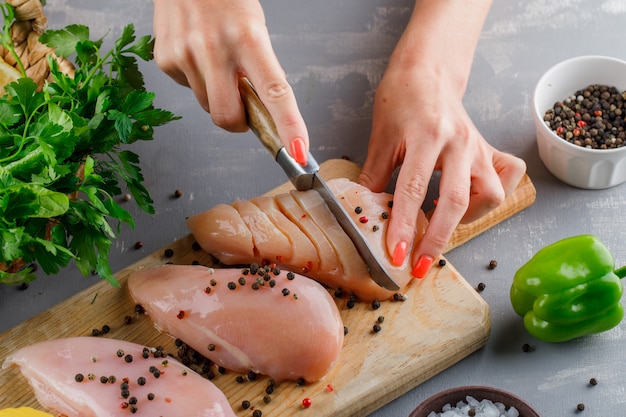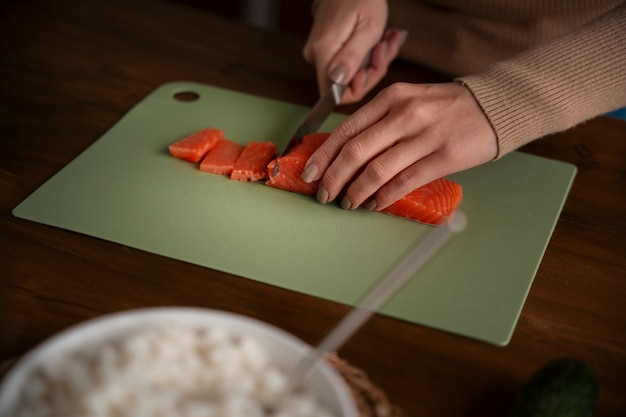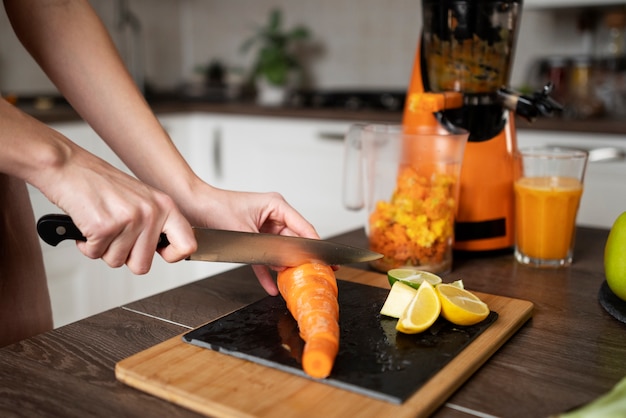As a seasoned cook, I've always loved the versatility of salmon. It's a beautiful fish that can be cooked in countless ways, and each method brings out its unique qualities. But let's be honest, figuring out the perfect cooking time for salmon can be tricky. You don't want to end up with dry, overcooked fish, or worse, a raw centre.
So, buckle up, because I'm about to share my tried-and-true tips and tricks for achieving perfectly cooked salmon every time. We'll delve into the different types of salmon, explore the most popular cooking methods, and break down the exact cooking times you need for each. Get ready to elevate your salmon game!
Part 1: Understanding the Basics

Salmon 101: Types and Thickness
The world of salmon is fascinating, but it can be a bit overwhelming for the beginner. Let's get the basics sorted out. Firstly, the type of salmon matters. You'll encounter wild salmon, known for its rich, intense flavour, and farmed salmon, which is generally milder in taste. Then comes the thickness. A thick fillet, like a whole side of salmon, needs a longer cooking time than a thin fillet.
I remember one time when I tried grilling a whole side of salmon, thinking it would be like grilling a steak. Oh boy, was I wrong! It took ages to cook through, and the outside was burnt before the inside was even close. Lesson learned: always consider the thickness!
Cooking Methods: A Quick Overview
Now, let's explore the most common ways to cook salmon:
Pan-frying: This is my go-to for a quick and easy weeknight meal. You get a crispy skin and a tender, juicy interior.
Baking in the Oven: Baking allows you to cook salmon with minimal fuss, giving you a beautiful crispy skin and wonderfully moist flesh.
Grilling: There's something about grilled salmon that screams summer. The smoky flavour and the char on the skin are irresistible.
Poaching: This gentle cooking method preserves the delicate texture of salmon and allows it to soak up the flavours of the poaching liquid. It's perfect for a light and elegant meal.
Let's explore each method in detail, giving you specific cooking times for different salmon thicknesses.
Part 2: Pan-Frying Salmon: The Quick and Easy Way

Pan-frying salmon is a simple and satisfying way to cook it. It's perfect when you're short on time, and the results are consistently delicious. Here's what you need to know:
Choosing the Right Pan
A cast-iron pan is the ultimate choice for pan-frying salmon. It heats up evenly and gets blazing hot, creating that perfect crispy skin. However, if you don't have one, a good quality stainless steel pan will do the trick.
Greasing the Pan
Before you start, always lightly grease your pan with oil or butter. This prevents the salmon from sticking and gives it a lovely golden-brown colour.
Cooking Time for Pan-Frying
Now, let's get to the heart of it - the cooking times. Remember, these are just guidelines. Adjust them based on your preference and the thickness of your salmon.
Table: Salmon Cooking Times for Pan-Frying
| Thickness | Cooking Time (One Side) |
|---|---|
| Thin (?? inch) | 3-4 minutes |
| Medium (1 inch) | 4-5 minutes |
| Thick (1 ?? inch) | 5-6 minutes |
Flip the salmon only once, when it's beautifully browned on one side. To test if it's cooked through, gently insert a fork into the thickest part. The salmon should flake easily and be opaque, with no pink remaining.
Tips for Perfect pan-fried salmon
Here are a few tricks to elevate your pan-frying game:
Season generously: Don't be shy with the salt and pepper! You can also add herbs like dill or thyme.
Don't overcrowd the pan: Give each piece of salmon enough space to cook evenly.
Keep an eye on the heat: You want the pan hot, but not scorching hot. If the pan is smoking, it's too hot.
Rest before serving: Let the salmon rest for a few minutes after cooking, allowing the juices to redistribute.
Part 3: baking salmon: For a Crispy Skin and Moist Flesh

If you're looking for a more relaxed approach to cooking salmon, baking is the way to go. It's a great option for a crowd-pleasing meal, yielding a perfectly crispy skin and wonderfully moist flesh.
Preheating Your Oven
Always preheat your oven to 400°F (200°C). This ensures even cooking and that irresistible crispy skin.
Choosing the Right Baking Dish
A baking sheet lined with parchment paper is the easiest and most convenient option. You can also use a baking dish, but make sure it's not too large, or the salmon might dry out.
Cooking Time for baked salmon
Here's a guide to baking times for different thicknesses:
Table: Salmon Cooking Times for Baking
| Thickness | Cooking Time |
|---|---|
| Thin (?? inch) | 12-15 minutes |
| Medium (1 inch) | 15-18 minutes |
| Thick (1 ?? inch) | 18-20 minutes |
When the salmon is cooked, it should flake easily and be opaque. If you're unsure, check the temperature with a meat thermometer. The internal temperature should be at least 145°F (63°C).
Tips for Baking Salmon
Seasoning: Before baking, season the salmon generously with salt, pepper, herbs, and lemon juice.
Glazing: For an extra layer of flavour, brush the salmon with a glaze made with honey, maple syrup, or a soy sauce mixture.
Roasting vegetables: While the salmon bakes, you can roast vegetables like asparagus, broccoli, or potatoes on the same baking sheet. It's a delicious and convenient way to cook a complete meal.
Part 4: Grilling Salmon: For a Smoky, Summery Flavour
There's something undeniably summery about grilling salmon. It imparts that smoky flavour and gives the skin a delicious char. Here's what you need to know about grilling salmon to perfection:
Preheating Your Grill
Get your grill nice and hot, about medium-high heat (around 400°F/200°C). This will ensure a beautiful sear and quick cooking time.
Choosing the Right Grill
Both gas and charcoal grills work well for salmon. If you're using a gas grill, make sure the grates are clean and lightly oiled. For charcoal grills, use hot coals and spread them evenly for consistent heat.
Cooking Time for Grilled Salmon
Here's a guide to grilling times for different thicknesses:
Table: Salmon Cooking Times for Grilling
| Thickness | Cooking Time (One Side) |
|---|---|
| Thin (?? inch) | 3-4 minutes |
| Medium (1 inch) | 4-5 minutes |
| Thick (1 ?? inch) | 5-6 minutes |
Flip the salmon only once, when it's nicely browned on one side. Test if it's cooked through by gently inserting a fork into the thickest part. It should flake easily and be opaque, with no pink remaining.
Tips for Grilling Salmon
Skin on or skin off? You can grill salmon with the skin on or off. If you're grilling skin-on, make sure the skin side is facing down.
Keep it moist: To prevent the salmon from drying out, brush it with a marinade or glaze.
Don't overcook: Salmon cooks quickly, so it's crucial not to overcook it.
Part 5: Poaching Salmon: A Gentle and Delicious Method
If you're looking for a gentler approach to cooking salmon, poaching is a great option. It results in a delicate texture and allows the salmon to absorb the flavours of the poaching liquid.
Choosing the Right Poaching Liquid
The simplest poaching liquid is water, but you can also add flavourings like wine, lemon juice, herbs, and spices. I've found that a mixture of white wine, lemon juice, dill, and bay leaves is particularly delicious.
Cooking Time for poached salmon
Poaching times vary depending on the thickness of the salmon and the temperature of the poaching liquid.
Table: Salmon Cooking Times for Poaching
| Thickness | Cooking Time |
|---|---|
| Thin (?? inch) | 5-7 minutes |
| Medium (1 inch) | 7-9 minutes |
| Thick (1 ?? inch) | 9-11 minutes |
Check if the salmon is cooked through by gently flaking it with a fork. It should be opaque and flake easily.
Tips for Poaching Salmon
Keep the liquid simmering: Don't let the liquid boil, or it will toughen the salmon.
Don't overcrowd the pot: Give the salmon enough space to cook evenly.
Cool the salmon in the poaching liquid: This will help the salmon retain its moisture.
Part 6: salmon and vegetables: A Perfect Pairing
Salmon is a wonderfully versatile fish that pairs beautifully with a variety of vegetables. Here are a few of my favourite combinations:
Roasted Vegetables
Roasted vegetables, like asparagus, broccoli, carrots, and potatoes, are a classic companion to salmon. You can even roast them on the same baking sheet as the salmon, which saves time and adds flavour.
grilled vegetables
For a summery vibe, try grilling vegetables like bell peppers, zucchini, and eggplant alongside your salmon. The smoky flavours complement each other beautifully.
Sautéed Vegetables
Sautéed vegetables, like spinach, kale, and mushrooms, are a quick and easy option that adds a pop of flavour and colour to your plate.
Tips for Pairing Salmon and Vegetables
Don't be afraid to experiment: There are endless possibilities when it comes to pairing salmon and vegetables. Try different combinations and find your favourites.
Consider the season: Use seasonal vegetables for the freshest flavours.
Keep it simple: Sometimes the best pairings are the simplest. A side of roasted broccoli or sautéed spinach is all you need.
Part 7: Glazes and Sauces: Taking Your Salmon to the Next Level
A good glaze or sauce can elevate your salmon dish from good to spectacular. Here are a few of my favourites that I always keep in my recipe arsenal:
Honey-Soy Glaze
This sweet and savory glaze is perfect for grilled or baked salmon. Simply whisk together honey, soy sauce, ginger, and garlic. Brush the glaze over the salmon before cooking and then again towards the end.
Lemon-Dill Sauce
This light and refreshing sauce is perfect for poached or pan-fried salmon. Simply combine lemon juice, dill, olive oil, salt, and pepper. Serve the sauce over the salmon or alongside it.
Creamy Herb Sauce
This creamy sauce is perfect for baked or grilled salmon. Simply whisk together cream cheese, sour cream, chopped herbs, and lemon juice. Serve the sauce over the salmon or alongside it.
Tips for Glazing and Saucing Salmon
Choose the right glaze or sauce for your cooking method: A honey-soy glaze works well for grilling, while a creamy herb sauce is perfect for baking.
Don't overdo it: A little glaze or sauce goes a long way.
Let it simmer: Allow the glaze or sauce to simmer for a few minutes before serving, so it thickens up.
Part 8: leftover salmon: Delicious Ways to Repurpose
Don't let those leftover salmon bits go to waste! There are countless ways to transform them into delicious meals.
Salmon Salad
Flake the leftover salmon and toss it with your favourite salad ingredients, such as chopped lettuce, tomatoes, cucumbers, and red onion. You can also add a dressing of your choice, like lemon vinaigrette or balsamic dressing.
Salmon Sandwiches
Make a simple and satisfying sandwich by topping bread with leftover salmon, cream cheese, and a few slices of cucumber. It's a great way to use up leftover salmon for lunch or a light dinner.
Salmon Pasta
Add flaked leftover salmon to your favourite pasta dish. It pairs well with creamy sauces, pesto, or even a simple tomato sauce.
Salmon Soup
Leftover salmon can be added to a creamy soup for a flavorful and satisfying meal. It's a great way to use up leftover salmon and vegetables.
Tips for Repurposing Leftover Salmon
Store it properly: Refrigerate leftover salmon in an airtight container for up to 3 days.
Be creative: Don't be afraid to experiment with different ways to use leftover salmon. The possibilities are endless!
FAQs
1. How do I know if salmon is cooked through?
The best way to tell if salmon is cooked through is to gently insert a fork into the thickest part. The salmon should flake easily and be opaque, with no hint of pink. You can also use a meat thermometer to check the internal temperature, which should be at least 145°F (63°C).
2. What happens if I overcook salmon?
overcooked salmon will be dry and tough. It's crucial to cook salmon to the right temperature, but not overcook it.
3. Can I cook salmon from frozen?
Yes, you can cook salmon from frozen. Just add a few minutes to the cooking time. For example, if you're baking a frozen salmon fillet, add about 5 minutes to the recommended baking time.
4. What are some good ways to season salmon?
Salmon is a versatile fish that can be seasoned in many different ways. Some popular options include salt, pepper, herbs like dill and thyme, lemon juice, and garlic. You can also use a spice rub or marinade.
5. How long can I keep cooked salmon in the refrigerator?
Cooked salmon can be stored in the refrigerator for up to 3 days. Be sure to refrigerate it promptly after cooking.
Everyone is watching

How to Cook Frozen Lobster Tails Perfectly: A Step-by-Step Guide
RecipesLobster. Just the word conjures up images of lavish meals, special occasions, and a taste of luxury. But let's...

Pork Fillet Cooking Time: How Long to Cook It Perfectly
RecipesPork fillet, or tenderloin as it's sometimes called, is a real favourite in our house. It's so versatile, and...

Pigs in a Blanket Cooking Time: How Long to Bake for Perfect Results
RecipesAh, pigs in a blanket. Just the name conjures up images of those delightful little parcels of crispy pastry en...

The Ultimate Guide to Cooking Delicious Frankfurters
RecipesLet's face it, we all love a good frankfurter. It's a classic, simple, and always satisfying. But let's be rea...

Wolf Meat Recipes: A Guide to Cooking Wild Game
RecipesLet's be honest, you don't see wolf meat at your local butcher shop every day. It's a bit of a wild card, but ...
